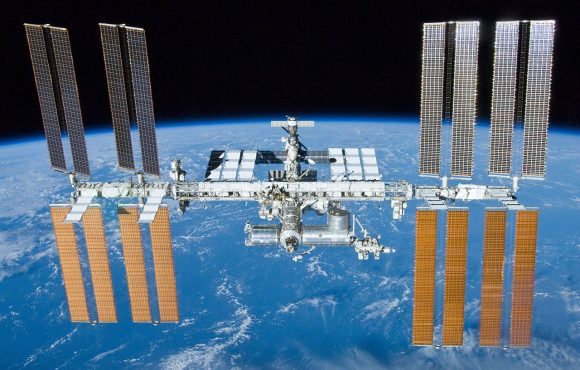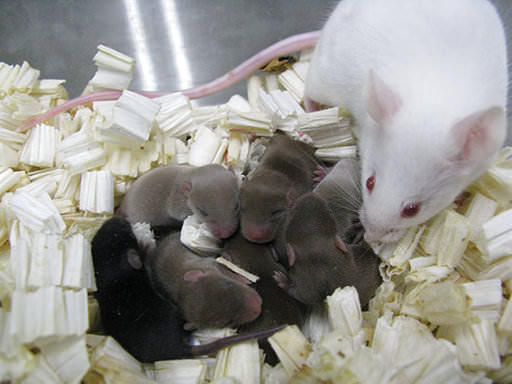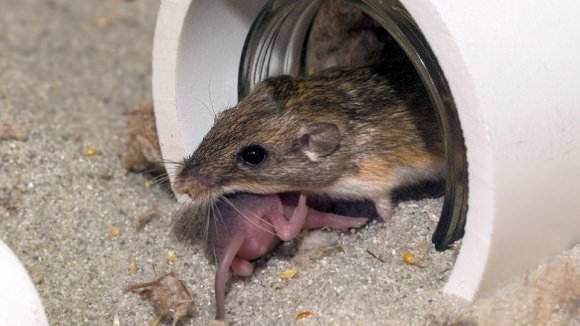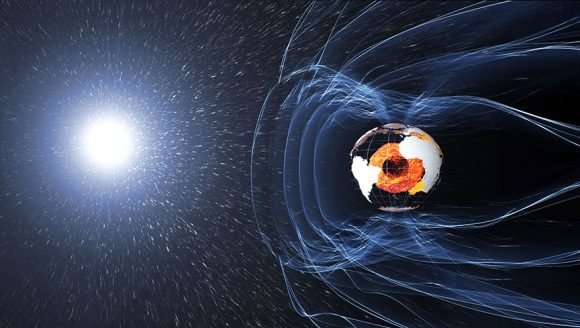With proposed missions to Mars and plans to establish outposts on the Moon in the coming decades, there are several questions about what effects time spent in space or on other planets could have on the human body. Beyond the normal range of questions concerning the effects of radiation and lower-g on our muscles, bones, and organs, there is also the question of how space travel could impact our ability to reproduce.
Earlier this week - on Monday, May 22nd - a team of Japanese researchers announced findings that could shed light on this question. Using a sample of freeze-dried mouse sperm, the team was able to produce a litter of healthy baby mice. As part of a fertility study, the mouse sperm had spent nine months aboard the International Space Station (between 2013 and 2014). The real question now is, can the same be done for human babies?
The study was led by Sayaka Wakayama, a student researcher at the University of Yamanashi's Advanced Biotechnology Center. As she and her colleagues explain in their study - which was recently published in the Proceedings of the National Academy of Sciences - assisted reproductive technology will be needed if humanity ever intends to live in space long-term.

The International Space Station (ISS), seen here with Earth as a backdrop. Credit: NASA
As such, studies that address the effect that living in space could have on human reproduction are needed first. These need to address the impact microgravity (or low-gravity) could have on fertility, human abilities to conceive, and the development of children. And more importantly, they need to deal with one of the greatest hazards of spending time in space - which is the threat posed by solar and cosmic radiation.
To be fair, one need not go far to feel the effects of space radiation. The ISS regularly receives more than 100 times the amount of radiation that Earth's surface does, which can result in genetic damage if sufficient safeguards are not in place. On other Solar bodies - like Mars and the Moon, which do not have a protective magnetosphere - the situation is similar.
And while the effects of radiation on adults has been studied extensively, the potential damage that could be caused to our offspring has not. How might solar and cosmic radiation affect our ability to reproduce, and how might this radiation affect children when they are still in the womb, and once they are born? Hoping to take the first steps in addressing these questions, Wakayama and her colleagues selected the spermatozoa of mice.
They specifically chose mice since they are a mammalian species that reproduces sexually. As Sayaka Wakayama explained Universe Today via email:
"So far, only fish or salamanders were examined for reproduction in space. However, mammalian species are very different compared to those species, such as being born from a mother (viviparity). To know whether mammalian reproduction is possible or not, we must use mammalian species for experiments. However, mammalian species such as mice or rats are very sensitive and difficult to take care of by astronauts aboard the ISS, especially for a reproduction study. Therefore, we [have not conducted these studies] until now. We are planning to do more experiments such as the effect of microgravity for embryo development."

Photo provided by University of Yamanashi, showing a white mouse foster mother with pups that were produced using freeze-dried sperm that spent 9 months aboard the ISS. Credit: Sayaka Wakayama/University of Yamanashi/AP
The samples spent nine months aboard the ISS, during which time they were kept at a constant temperature of -95 °C (-139 °F). During launch and recovery, however, they were at room temperature. After retrieval, Wakayama and her team found that the samples had suffered some minor damage,.
"Sperm preserved in space had DNA damage even after only 9 months by space radiation," said Wakayama. "However, that damage was not strong and could be repaired when fertilized by oocytes capacity. Therefore, we could obtain normal, healthy offspring. This suggests to me that we must examine the effect when sperm are preserved for longer periods."
In addition to being reparable, the sperm samples were still able to fertilize mouse embryos (once they were brought back to Earth) and produce mouse offspring, all of which grew to maturity and showed normal fertility levels. They also noted that the fertilization and birth rates were similar to those of control groups, and that only minor genomic differences existed between those and the mouse created using the test sperm.
From all this, they demonstrated that while exposure to space radiation can damage DNA, it need not affect the production of viable offspring (at least within a nine month period). Moreover, the results indicate that human and domestic animals could be produced from space-preserved spermatozoa, which could be mighty useful when it comes to colonizing space and other planets.

A Pacific pocket mouse pup and its mother appear outside their artificial burrow at the San Diego Zoo. Credit: Ken Bohn/San Diego Zoo/AP
As Wakayama put it, this research builds on fertilization practices already established on Earth, and demonstrated that these same practices could be used in space:
"Our main subject is domestic animal reproduction. In the current situation on the ground, many animals are born from preserves spermatozoa. Especially in Japan, 100% of milk cows were born from preserved sperm due to economic and breeding reasons. Sometimes, sperm that has been stored for more than 10 years was used to produce cows. If humans live in space for many years, then, our results showed that we can eat beefsteak in the space. For that purpose, we did this study. For humans, our finding will probably help infertile couples."
This research also paves the way for additional tests that would seek to measure the effects of space radiation on ova and the female reproduction system. Not only could these tests tell us a great deal about how time in space could affect female fertility, it could also have serious implications for astronaut safety. As Ulrike Luderer, a professor of medicine at the University of California and one of the co-authors on the paper said in a statement to the AFP:
"These types of exposures can cause early ovarian failure and ovarian cancer, as well as other osteoporosis, cardiovascular disease and neurocognitive diseases like Alzheimer's. Half the astronauts in the NASA's new astronaut classes are women. So it is really important to know what chronic health effects there could be for women exposed to long-term deep space radiation."

Beyond Earth's magnetosphere, solar and cosmic radiation poses a significant risk to health and possibly fertility. Credit: ESA/ATG medialab
However, a lingering issue with these sorts of tests is being able to differentiate between the effects of microgravity and radiation. In the past, research has been conducted that showed how exposure to simulated microgravity can reduce DNA repair capacity and induce DNA damage in humans. Other studies have raised the issue of the interplay between the two, and how further experiments are needed to address the precise impact of each.
In the future, it may be possible to differentiate between the two by placing samples of spermatazoa and ova in a torus that is capable of simulating Earth gravity (1 g). Similarly, shielded modules could be used to isolate the effects of low or even micro-gravity. Beyond that, there will likely be lingering uncertainties until such time as babies are actually born in space, or in a lunar or Martian environment.
And of course, the long-terms impact of reduced gravity and radiation on human evolution remains to be seen. In all likelihood, that won't become clear for generations to come, and will require multi-generational studies of children born away from Earth to see how they and their progeny differ.
Further Reading: PNAS, AFP
No comments:
Post a Comment